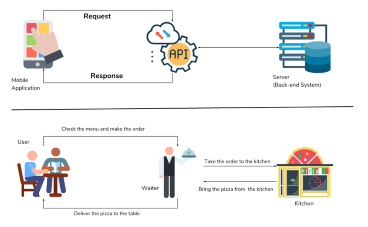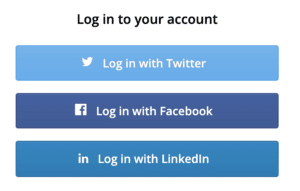According to a study by Deloitte, over 22% of banks already use their own APIs while 39% are actively working on APIs deployment.
This makes sense as the phrase “open banking” has become more relevant and widely accepted in the financial sector. Even more so, after the introduction of the revised Payment Services Directive – known as PSD2 by the European Parliament in 2015.
If you don’t know what open banking is, here’s what it means.
Open Banking basically is a part of financial technology which refers to the use of open APIs that enable third-party financial providers to build apps and services around a financial institution with access to transactions, consumer banking, and other financial data from banks.
The idea behind introducing APIs in finance was to give users more options, APIs are being used in the financial industry for much more than that. In this article, we will talk in length about the deployment of APIs in finance but before we begin with that – what are APIs and why use them?
Why APIs?
Application Programming Interfaces (APIs) are, in a way, communicators between users and the system behind the screen. In simple terms, if you click on “Add to cart”, the API conveys this message to the system and it updates your cart.
Developers use the JavaScript Object Notation – JSON to make a specific “request” or “call’ through APIs. There are 4 basic methods that APIs use to make a specific request:
- PUT – The “PUT” method is used to update information, pricing of products in an e-Commerce store for instance.
- GET – This method is used to gather/retrieve information or a representation of a resource by the APIs.
- DELETE – This method (obviously) deletes a resource identified by its URI.
- POST – This request method is used to create new resources. This is one of the most commonly used methods in the deployment of financial APIs.
There are many other methods used by APIs like PATCH but these are the basic ones. Having said that, what makes APIs important for your business?
To begin with, APIs make it simpler for two applications to communicate with each other for the sake of the convenience of your consumers. It’s as simple as that.

Apart from this, here are a few reasons why APIs are used by businesses from different industries.
-
Cost-Effectiveness
The cost of offering a variety of services would be too costly to implement if it weren’t for APIs.
Using APIs effectively can help you significantly reduce costs for your business. One such instance is using APIs to reduce operational/technology costs. APIs help you simplify and accelerate development.
-
Better User Experience
As an entrepreneur, you know that one size doesn’t fit all in today’s market. Your different consumers have different needs and creating a personalized experience is why APIs become more beneficial for businesses.
You can integrate your application with any third-party platform using APIs, you get a better understanding of your users and what they want from your business. Using these insights, APIs can help you create a more personalized experience for your customers which can serve your business in the long run!
-
Ease of Integration
This is one of the USPs of why to use APIs for your business. They simplify the integration of third-party software in your application. You can use the results thus driven, therefore, to use the integrations that you users are siding with.
Keep in mind that the ease of integration is what makes it all possible, testing different integrations for your users to improve your application’s usability without spending a fortune in development costs.
To give you a perspective, remember how you can use your social media handles to create your account on many platforms? Well, this has become possible because of APIs.

Why Use APIs in Finance?
The financial sector is witnessing a huge spike in the implementation of APIs and for all the right reasons. They help financial institutions to quickly launch their services and thus, start receiving ROI at an early stage.
If we digress from the cost benefits of APIs in financial services, they help banks and other financial institutions create enhanced digital products and services customized to their customers’ needs. This helps them to get in the good books of their customers while simplifying banking all the while.
Now, let’s look at why use APIs in financial services and how different APIs are completely revolutionizing the banking industry.
Financial Data Aggregation APIs
Financial data aggregation is one of the most innovative ways of how APIs are being used in financial services. If you don’t know what Financial Data Aggregation is, here is a quick brief about it.
Customer data helps financial firms/banks to truly understand their customers. With the use of APIs, Data Aggregation companies help financial firms to “hand over their information by seamlessly signing into their accounts” while ensuring top-level security.
Plaid is a classic example of a data aggregation company. It simply plays the role of a middleman between bank account and financial apps.
Let’s say that you request your account balance using one of these financial apps. Data Aggregation companies like Plaid completely encrypt and deliver your account balance or any other information as securely as possible.
Financial Data Aggregation APIs make banking truly mobile by optimization of services, reducing costs, cutting time spent in completing transactions, and much more.
Modular and Simple
APIs in financial services allow integration, from consumer-facing channels, and payment gateways to card processing and much more, by enabling a modular system architecture.
This allows financial institutions and firms to work with the best service providers in each area to give the best services to their customers.
For instance, take investment management APIs like Addepar. They have made it easier for firms and financial advisors to manage investments like never before with its integration with CRMs like Salesforce.
Data Security and Regulation
With accessibility comes the question of security but APIs handle that quite efficiently. When the accessibility of financial records is handled by APIs, the process definitely becomes more secure than the traditional file-driven approach.
APIs ensure top-class encryption to keep sensitive data fully secure. Having said that Policy Enforcement Points (PEP) can definitely be used to manage and govern the use of APIs in financial services.
It can be used to combat fraud and to limit the usage of APIs in financial services only to its benefits.
The New Norm
With unprecedented events like the ongoing COVID-19 outbreak, the use of APIs in financial services become more important than ever. To begin with, such events call for customization in services in a way that no intelligence software could ever predict.
The use of APIs in financial services can increase the accessibility of banking services to an array of services while implementing personalization wherever necessary.
Examples of APIs in Finance
APIs in financial services have traveled a long way and still have many miles to go. They have evolved from their primary purpose to further simplify banking
In a research paper titled “Executing the open banking strategy in the United States”, Deloitte observes – “While it was designed to give customers more choice, open banking may end up making customers better understand and appreciate the value of one of their key assets: their data.”
The idea of open banking and APIs in financial services has given a huge boost in the rise of different varieties of third-party APIs. These APIs have helped users to get access to services that weren’t available to them via conventional/traditional banking systems.
End consumers and businesses are now used to 24/7 access to their financial data in real-time and APIs in financial services are playing a revolutionizing role in all of it.
Here are a few examples of APIs in the financial sector.
-
Plaid
Plaid is a classic example of how far APIs have traveled in financial services. In Jan 2020, Visa acquired Plaid for $5.3 billion – twice the amount of its private evaluation.
The company started as a simple API that helped its consumers to easily share their financial information but the platform expanded after it acquired Quovo.
After the acquisition, Plaid was more than an API that could interact with just savings and checking accounts. It extended its service offerings to a wider array of financial assets.
-
Trulioo
Trulioo is another example of APIs in financial services that are revolutionizing the banking industry. It is currently used in more than 80 countries.
Trulioo basically is a global identity verification service that allows banks and financial institutions to scale while adhering to Know Your Customer (KYC) and Anti-Money Laundering (AML) compliance processes.
Trulioo GlobalGateway API is a marketplace that allows businesses to verify identities easily and seamlessly.
-
Dwolla
Dwolla’s programmable payments platform is basically an API that enables payment partners to integrate the full extent of the bank transfer system to their own platforms.
This has simplified complex processes by creating a structure for collecting, sending, and enabling payments between users. As new CEO, Brady Harris, explains: “Using API, you have a highly customized programmable payment that can be integrated into the software, apps, platforms, and dashboards. And it’s a fraction of the cost.”
Final Words
APIs in financial services have open roads to new possibilities for innovation in creating custom customer experiences and have moved beyond just internal usage. Financial firms and banking institutions should consider using APIs to drive better revenues and scale quickly.
As a leading app & web development company, RNF offers end-to-end custom development solutions as per your specific business needs. From development & design to migration, testing, and support, we do it all!
Got a project in mind? Why not test our skills? Get in touch with us now!
